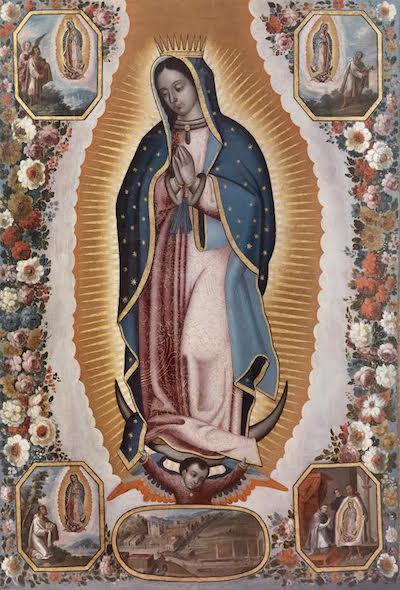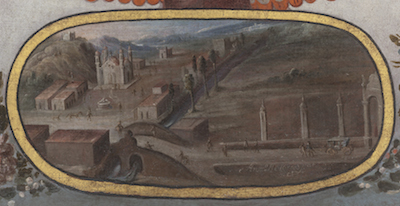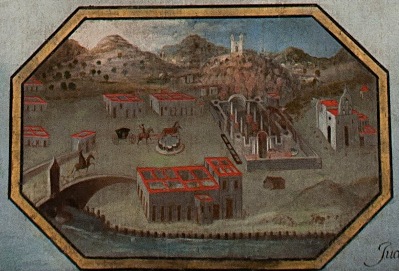Our new painting of Antonio de Torres’ Virgin of Guadalupe (c. 1725) was just installed last week in the Art of the Americas Building. The nearly life-sized image depicts the radiant Virgin of Guadalupe, her body enveloped in a golden mandorla surrounded by lush flowers. Each corner includes a vignette detailing the miraculous appearance of the Virgin to the Indian Juan Diego, while a larger roundel at the feet of the Virgin depicts a view of her sanctuary (more on this recent acquisition here).
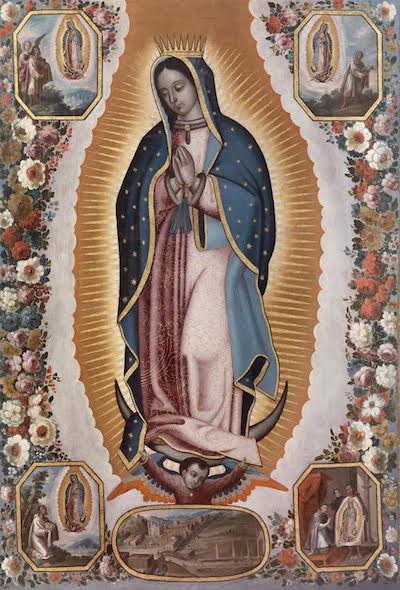 Antonio de Torres, Virgin of Guadalupe (Virgen de Guadalupe), c. 1725, gift of Kelvin Davis through the 2014 Collectors Committee
Antonio de Torres, Virgin of Guadalupe (Virgen de Guadalupe), c. 1725, gift of Kelvin Davis through the 2014 Collectors Committee
Torres’ rendering of the sanctuary is an intriguing part of the painting. In the far upper left, we see a small chapel on the Tepeyac hill; this was the Virgin’s early shrine, which marks the site of her first apparition to Juan Diego. At the base of the hill lies the new sanctuary, completed in 1709, and beyond that, a more modest church that was dedicated in 1622. The religious complex is surrounded by a sizeable plaza with a fountain and outlying buildings. The Río Guadalupe bisects the roundel diagonally while the Calzada de los Misterios, a major thoroughfare that connected the sanctuary to Mexico City, is clearly depicted in the foreground.
Images of the new sanctuary of Guadalupe and its surroundings appear on paintings of the Virgin as early as 1702, before the building was completed. In the detail below, from an artwork in the collection of the Museo de América, Madrid, the painter Juan de Villegas (active in Mexico in the first half of the eighteenth century) documents the construction of the sanctuary.
Funded initially by donations from local devotees, the sanctuary received major support from the newly appointed viceroy of New Spain, Francisco Fernández de la Cueva, duke of Albuquerque (r. 1702–11), who arrived in New Spain in 1702. Seven years after his arrival, the viceroy commissioned the painter Manuel Arellano (c. 1663–1722) to memorialize the dedication of the new sanctuary. By supporting the sanctuary and documenting it through the Arellano painting, the viceroy established himself as a devout ruler with a keen understanding of the importance of the growing local cult.
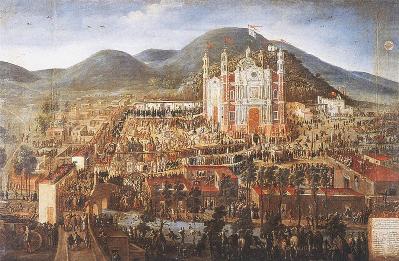 Attributed to Manuel Arellano, Transfer of the Image and Inauguration of the Sanctuary of the Virgin of Guadalupe, 1709, private collection, Spain
Attributed to Manuel Arellano, Transfer of the Image and Inauguration of the Sanctuary of the Virgin of Guadalupe, 1709, private collection, Spain
If Arellano’s early image of the sanctuary carried a political meaning, what can we make of our later example by Torres? At first glance, the roundel seems somewhat incongruous, appearing neither particularly centered on a focal point of interest, such as the sanctuary, or upon an activity, such as the construction or festivities surrounding the dedication. In fact, though Torres depicts the sanctuary of Guadalupe, the artist de-emphasizes the building not only through its placement in the far upper left quadrant of the roundel but also by showing the northern exterior wall rather than the façade. The perspective is also slightly skewed: the sanctuary is depicted as if viewed from a considerable distance and from a great height while the road and bridge in the foreground are presented from a lower vantage point and appear quite large. This is not a lack of mastery on the part of the artist, rather a clear sign that he intended to emphasize the thoroughfares surrounding the sanctuary—the Río Guadalupe and the Calzada de los Misterios.
As an important pilgrimage site whose cult was steadily growing in the eighteenth century, the sanctuary of Guadalupe had to be reasonably accessible. Through this depiction, Torres illustrates not just the availability of good roads to reach the holy site, but also various pilgrims from different social classes. In the foreground, he shows people approaching on foot, on horseback, and, at the far right, in a carriage. Two pairs of figures climb the hill behind the sanctuary—the original site of the Virgin’s apparition. In 1722 Torres was selected to inspect the original miraculous image of the Virgin housed at the sanctuary, and therefore we can surmise that the scene is based on his observation. The roundel thus functions both cartographically and as a first person pictorial account of the famous site and surrounding activities. Whether intended for immediate export to Europe or for a Mexican audience, Torres’ painting of the Virgin of Guadalupe and the view of Tepeyac pays homage to a uniquely New World phenomenon while encouraging the pilgrimage to, and therefore furthering the development of, the increasingly international cult of Guadalupe. JoAnna Reyes Walton, Research Assistant, Latin American art department



